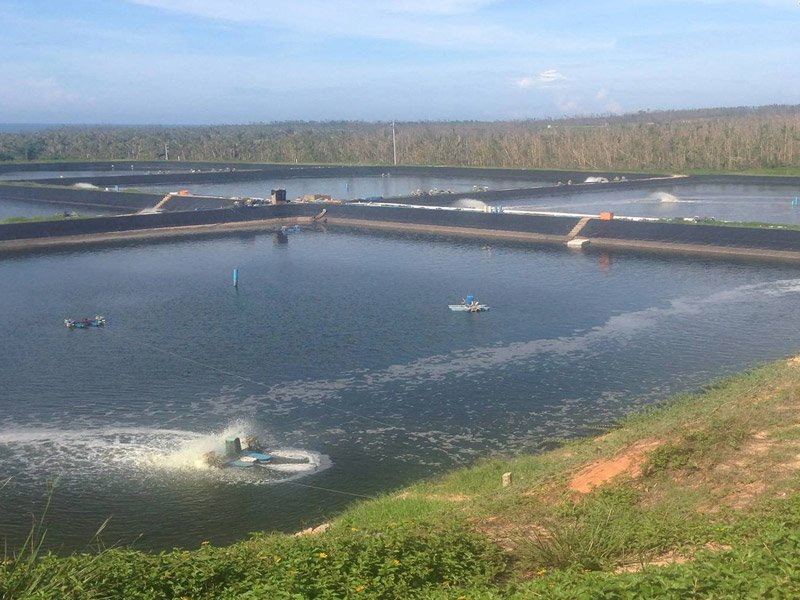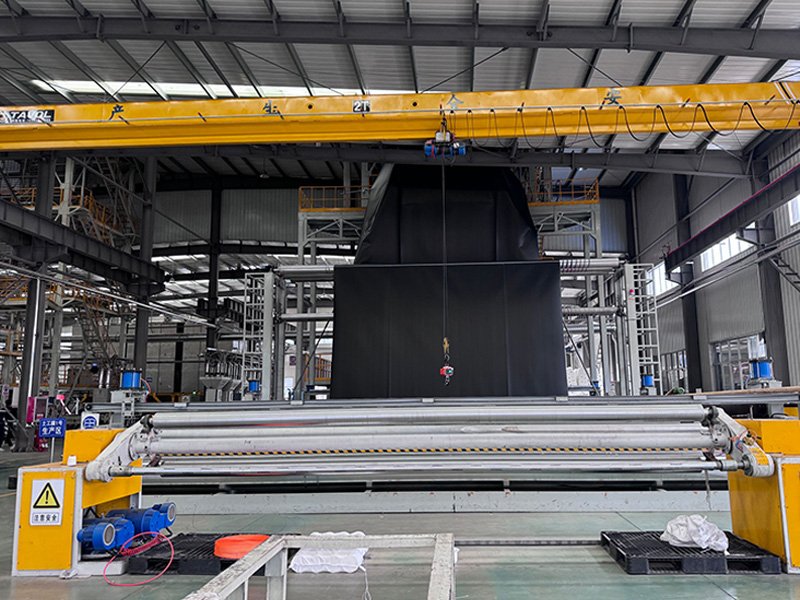LDPE geomembrane, manufactured from virgin polyethylene resins, offers great flexibility, low-temperature resistance, and UV protection. Economical and durable, it exhibits high strength and puncture resistance, making it suitable for a variety of applications, such as pools, canals, landfills, tunnels, landscapes, and mining projects. Its versatility and cost-effectiveness make it a popular choice for long-lasting waterproofing and containment solutions.
As the leading geomembrane manufacturer and supplier, BPM Geosynthetics offers LDPE and HDPE geomembrane liner in custom thickness and size at best factory price. In this article, let us explore the definition, features and applications of LDPE geomembrane from the manufacturer’s view, we think it will help you a lot when you choosing the right LDPE geomembrane liner for your specific projects.
1. What Is LDPE Geomembrane?
LDPE geomembrane refers to a type of geomembrane made from low-density polyethylene (LDPE) material. Geomembranes are impermeable liners used in various civil engineering and environmental applications to control fluid migration and prevent contamination. LDPE is a thermoplastic polymer known for its flexibility, durability, and resistance to chemicals and UV radiation.
LDPE geomembranes are manufactured by extruding LDPE resin into large sheets or rolls of varying thicknesses. These sheets are then typically welded together to form a continuous impermeable barrier. The seams are created using various techniques, such as thermal fusion, hot-air welding, or extrusion welding, to ensure a strong and watertight bond.
LDPE geomembranes are commonly used in applications such as landfill liners, mining and tailings pond liners, agricultural and irrigation ponds, secondary containment systems, wastewater treatment facilities, and water storage reservoirs. They provide an effective barrier against the migration of liquids, gases, and contaminants, helping to protect the environment and ensure the integrity of structures.
LDPE geomembranas are widely used in civil engineering and environmental projects to provide reliable and long-lasting containment solutions.


2. What Are Benefits Of LDPE Geomembrane?
LDPE geomembranes are versatile, durable, and offer excellent protection and performance in a wide range of applications, from water management to environmental protection and construction projects.
2.1 Physical and Mechanical Strength
LDPE has good physical properties and mechanical strength, ensuring the geomembrane can withstand various environmental conditions and physical stresses.
2.2 Tearing Resistance
With high tearing resistance, LDPE geomembranes are less likely to be damaged by sharp objects or rough surfaces.
2.3 Deformation Adaptability
LDPE geomembranes have strong adaptability to deformation, which is crucial for applications where the ground may shift or settle over time.
2.4 Anti-Aging and UV Resistance
LDPE geomembrane has excellent anti-aging properties and are resistant to ultraviolet light, which helps maintain their integrity over long periods.
2.5 Weather Resistance
LDPE geomembrane is designed to withstand a range of weather conditions, including extreme temperatures.
2.6 Waterproofing and Anti-Seepage
LDPE provides good waterproofing, drainage, anti-seepage, and damp proof effects, making it ideal for applications requiring water containment or exclusion.
2.7 Puncture Resistance
The LDPE geomembrane has a perfect resistance to puncture, which can protect against damage from most plant roots, an important feature in landscaping and agriculture.
2.8 Chemical Stability
LDPE geomembrane offers excellent stability against acids, alkalis, salt solutions, oils, and alcohols, which is important for environmental protection and containment.
2.9 Cost-Effective
LDPE geomembranes are a cost-effective solution with a long service life, providing value over time.
2.10 Customization
LDPE geomembranes are available for OEM (Original Equipment Manufacturer) and ODM (Original Design Manufacturer) services, allowing for customization to meet specific project needs.
3. What Is LDPE Geomembrane Used For?
LDPE geomembranes are suitable for a wide range of civil engineering and environmental projects that require containment and barrier systems. Here are some of the applicable projects where LDPE geomembranes are commonly used:
3.1 Landfills
LDPE geomembranes are extensively used as liners and caps in landfill projects. They prevent the migration of leachate (liquid waste) into the surrounding soil and groundwater, reducing the risk of contamination.
3.2 Mining and tailings ponds
LDPE Geomembranes made from LDPE are used as liners in mining operations and tailings ponds. They create a barrier to prevent the seepage of potentially harmful chemicals and pollutants into the environment.
3.3 Water and wastewater treatment facilities
LDPE geomembranes are employed in the construction of water and wastewater treatment facilities. They help to line tanks, basins, and lagoons, ensuring containment and preventing the loss of treated water or the intrusion of contaminants.
3.4 Agricultural and irrigation ponds
LDPE geomembranes are used to line agricultural and irrigation ponds, preventing water loss through seepage and maintaining proper water levels for crop irrigation.
3.5 Secondary containment systems
LDPE geomembranes are utilized in secondary containment systems to prevent the leakage of hazardous substances from storage tanks, chemical processing areas, and industrial facilities. They provide an extra layer of protection against potential environmental contamination.
3.6 Water storage reservoirs
LDPE geomembranes are employed in the construction of water storage reservoirs, ensuring water retention and preventing seepage into the surrounding soil.
3.7 Pond and canal liners
LDPE geomembranes are used to line ponds, canals, and other water management structures, preventing seepage and maintaining water levels.
4. What Is Difference of LDPE vs HDPE Geomembrane
LDPE (low-density polyethylene) geomembranes and HDPE (high-density polyethylene) geomembranes are two different types of geomembranes with distinct characteristics. Here are the key differences between LDPE and HDPE geomembranes:
4.1 Density
The primary difference lies in the density of the polyethylene material. LDPE has a lower density compared to HDPE. LDPE typically has a density ranging from 0.910 to 0.940 g/cm³, while HDPE has a higher density of 0.940 to 0.970 g/cm³. The difference in density affects their mechanical properties.
4.2 Flexibility
LDPE geomembranes are more flexible and have higher elongation properties compared to HDPE geomembranes. This flexibility allows LDPE to conform better to irregular surfaces and withstand movements and deformations.
4.3 Chemical Resistance
Both LDPE and HDPE are known for their excellent chemical resistance. However, HDPE geomembranes generally exhibit superior chemical resistance compared to LDPE geomembranes. HDPE is more resistant to a wide range of chemicals, including acids, alkalis, and hydrocarbons.
4.4 Strength and Stiffness
HDPE geomembranes are stronger and stiffer than LDPE geomembranes. HDPE provides better tensile strength, tear resistance, and puncture resistance, making it suitable for projects that require higher mechanical properties.
4.5 UV Resistance
HDPE geomembranes typically have better UV resistance than LDPE geomembranes. HDPE can withstand prolonged exposure to sunlight and environmental conditions without significant degradation. LDPE geomembranes may require the addition of UV stabilizers to enhance their resistance to UV radiation.
4.6 Weldability
Both LDPE and HDPE geomembranes are weldable using various techniques like thermal fusion, hot-air welding, or extrusion welding. However, the welding parameters and techniques may vary depending on the specific material and its properties.


5. How To Install LDPE geomembrane ForThe Reservoir Project?
In the installation of LDPE geomembrane for a reservoir, the following steps are typically involved:
Site Preparation: The reservoir area needs to be properly prepared before installing the LDPE geomembrane. This includes clearing the site of any debris, vegetation, or sharp objects that could potentially puncture or damage the geomembrane. The subgrade should be leveled and compacted to provide a stable foundation.
Geomembrane Panels/Sheets: LDPE geomembranes are typically supplied in large rolls or panels. These panels need to be carefully unrolled or unfolded to cover the designated area of the reservoir. Special care should be taken to avoid folds, creases, or wrinkles that could compromise the integrity of the liner.
Anchoring and Seaming: The geomembrane panels are anchored to the ground using methods such as soil cover, ballast, or anchor trenches. This helps secure the geomembrane in place and prevents uplift or movement due to water pressure. The panels are then seamed together using welding techniques appropriate for LDPE, such as thermal fusion, hot-air welding, or extrusion welding. The seams should be strong and watertight to ensure the integrity of the liner system.
Pipe and Penetration Sealing: Special attention should be given to sealing around pipes, fittings, and other penetrations that pass through the LDPE geomembrane. This is typically done using compatible sealing materials or techniques to prevent water leakage at these points.
Quality Control and Testing: Throughout the installation process, quality control measures should be implemented to ensure the proper installation of the LDPE geomembrane. This may include visual inspections, leak testing, and verifying seam integrity. Any defects or issues should be addressed and rectified promptly.
Backfilling and Protection: Once the LDPE geomembrane is installed and secured, suitable backfill material is placed on top of the liner to protect it from UV exposure, mechanical damage, and erosion. The backfill material should be carefully selected to avoid sharp objects or materials that may cause damage to the geomembrane.
6. Summary
LDPE geomembranes are a versatile and durable choice for a wide range of applications, from water management to environmental protection and construction projects. Manufactured from virgin polyethylene resins, LDPE geomembranes offer excellent flexibility, low-temperature resistance, and robust protection against ultraviolet exposure.
LDPE geomembranes are suitable for a variety of civil engineering and environmental projects that require reliable containment and barrier systems. The selection of LDPE geomembranes is based on factors such as required thickness, chemical resistance, puncture resistance, and installation conditions. Specialized additives can be incorporated into the LDPE formulation to enhance specific properties, such as UV stabilizers for increased longevity in outdoor applications.
With their cost-effectiveness, durability, and versatility, LDPE geomembranes have become a preferred choice for designers and engineers seeking high-performance containment solutions across diverse industries and environments.
Any questions, please contact us.





